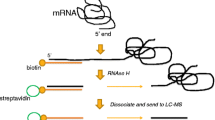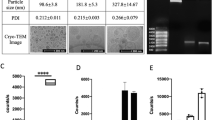Abstract
There are multiple pathways of intracellular protein degradation, and molecular determinants within proteins appear to target them for particular pathways of breakdown. We use red cell-mediated microinjection to introduce radiolabeled proteins into cultured human fibroblasts in order to follow their catabolism. A well-characterized protein, bovine pancreatic ribonuclease A (RNase A), is localized initially in the cytosol of cells after microinjection, but it is subsequently taken up and degraded by lysosomes. This lysosomal pathway of proteolysis is subject to regulation in that RNase A is taken up and degraded by lysosomes at twice the rate when serum is omitted from the culture medium. Subtilisin cleaves RNase A between residues 20 and 21, and the separated fragments are termed RNase S-peptide (residues 1–20) and RNase S-protein (residues 21–124). Microinjected RNase S-protein is degraded in a serum-independent manner, while RNase S-peptide microinjected alone shows a twofold increase in degradation in response to serum withdrawal. Furthermore, covalent linkage of S-peptide to other proteins prior to microinjection causes degradation of the conjugate to become serum responsive. These results show that recognition of RNase A and certain other proteins for enhanced lysosomal degradation during serum withdrawal is based on some feature of the amino-terminal 20 amino acids. The entire S-peptide is not required for enhanced lysosomal degradation during serum withdrawal because degradation of certain fragments is also responsive to serum. We have identified the essential region to be within residues 7–11 of RNase S-peptide (Lys-Phe-Glu-Arg-Gln; KFERQ). To determine whether related peptides exist in cellular proteins, we raised antibodies to the pentapeptide. Affinity-purified antibodies to KFERQ specifically precipitate 25–35% of cellular proteins, and these proteins are preferentially degraded in response to serum withdrawal. Computer analyses of known protein sequences indicate that proteins degraded by lysosomes at an enhanced rate in response to serum withdrawal contain peptide regions related, but not identical, to KFERQ. We suggest two possible peptide motifs related to KFERQ and speculate about possible mechanisms of selective delivery of proteins to lysosomes based on such peptide regions.
Similar content being viewed by others
References
Ahlberg, J., Berkenstam, A., Henell, F., and Glaumann, H. (1985).J. Biol. Chem. 260, 5847–5854.
Ahlberg, J., Marzella, L., and Glaumann, H. (1982).Lab. Invest. 47, 523–532.
Amenta, J., Hlivko, T., McBee, A., Shimozuka, H., and Brocher, S. (1978a).Exp. Cell Res. 115, 357–366.
Amenta, J., Sargus, M., Venkatesan, S., and Shinozuka, H. (1978b).J. Cell. Physiol. 94, 77–86.
Auteri, J., Okada, A., Bochaki, V., and Dice, J. (1983).J. Cell. Physiol. 155, 167–174.
Bachmair, A., Finley, D., and Varshavsky, A. (1986).Science 234, 179–186.
Backer, J., and Dice, J. (1986).Proc. Natl. Acad. Sci. USA 83, 5830–5834.
Backer, J., Bourret, L., and Dice, J. (1983).Proc. Natl. Acad. Sci. USA 80, 2166–2170.
Bigelow, S., Hough, R., and Rechsteiner, M. (1981).Cell 25, 83–93.
Blackburn, P., and Moore, S. (1982). InThe Enzymes. Vol. 15 (Boyer, P. D., ed.), Academic Press, New York, pp. 317–433.
Bond, J., and Butler, J. (1987).Annu. Rev. Biochem. 56, 333–364.
Carlson, N., and Rechsteiner, M. (1987).J. Cell Biol. 104, 537–546.
Carlson, N., Rogers, S., and Rechsteiner, M. (1987).J. Cell Biol. 104, 547–555.
Chiang, H.-L., and Dice, J. (1986).J. Biol. Chem. (submitted).
Chin, D., Kuehl, L., and Rechsteiner, M. (1982).Proc. Natl. Acad. Sci. USA 79, 5857–5861.
Ciechanover, A., Finley, D., and Varshavsky, A. (1984).Cell 37, 57–66.
Dean, R. (1979).Biochem. J. 180, 339–345.
Desautels, M., and Goldberg, A. (1982).J. Biol. Chem. 257, 11673–11679.
Dice, J. (1987).FASEB J. (in press).
Dice, J., and Walker, C. (1980). InProtein Degradation in Health and Disease (Barret, A. J., ed.), Excerpta Medica, Amsterdam, pp. 331–350.
Dice, J., Chiang, H.-L., Spencer, E., and Backer, J. (1986).J. Biol. Chem. 261, 6853–6859.
Etlinger, J., and Goldberg, A. (1977).Proc. Natl. Acad. Sci. USA 75, 54–58.
Ferber, S., and Ciechanover, A. (1987).Nature (Lond.) 326, 808–811.
Finley, D., Ozkaynak, E., and Varshavsky, A. (1987).Cell 48, 1035–1046.
Finley, D., and Varshavsky, A. (1985).Trends Biochem. Sci. 10, 343–346.
Fried, V., Smith, H., Hildebrandt, E., and Weiner, K. (1987).Proc. Natl. Acad. Sci. USA 84, 3685–3689.
Goldberg, A., and St. John, A. (1976).Annu. Rev. Biochem. 45, 747–803.
Hendil, K. (1980).J. Cell. Physiol. 105, 449–460.
Hershko, A., and Ciechanover, A. (1982).Annu. Rev. Biochem. 51, 335–364.
Hershko, A., Heller, H., Eytan, E., Kaklu, G., and Rose, I. A. (1984).Proc. Natl. Acad. Sci. USA 81, 7021–7025.
Janeczko, R., Carriere, R., and Etlinger, J. (1985).J. Biol. Chem. 260, 7051–7058.
Knowles, S., and Ballard, F. (1976).Biochem. J. 156, 609–617.
Kyte, J., and Doolittle, R. (1982).J. Mol. Biol. 157, 105–132.
Masaki, R., Yamamoto, A., and Tashiro, Y. (1987).J. Cell Biol. 104, 1207–1216.
McElligott, M., and Dice, J. (1984).Biosci. Rep. 4, 451–466.
McElligott, M., Miao, P., and Dice, J. (1985).J. Biol. Chem. 260, 11986–11993.
McGarry, T., Hough, R., Rogers, S., and Rechsteiner, M. (1983).J. Cell Biol. 96, 338–346.
Mortimore, G., and Poso, A. (1984)Fed. Proc. 43, 1289–1294.
Murakami, K., and Etlinger, J. (1986).Proc. Natl. Acad. Sci. USA 83, 7588–7593.
Neff, N., Bourret, L., Miao, P., and Dice, J. (1981).J. Cell Biol. 91, 184–194.
Novikoff, A. B., and Shin, W. (1978).Proc. Natl. Acad. Sci. USA 75, 5039–5042.
Ohkuma, S., and Poole, B. (1978).Proc. Natl. Acad. Sci. USA 75, 3327–3331.
Pontremoli, S., and Melloni, E. (1986).Annu. Rev. Biochem. 55, 455–482.
Richards, F., and Vithayathil, P. (1959).J. Biol. Chem. 234, 1459–1465.
Richards, F., and Wyckoff, H. (1971). InThe Enzymes, Vol. 4 (Boyer, P. D., ed.), Academic Press, New York, pp. 647–806.
Rogers, S., Wells, R., and Rechsteiner, M. (1986).Science 234, 364–368.
Schatz, G. (1986).Nature (Lond.) 321, 108–109.
Schimke, R. (1970).Mammalian Protein Metab. 4, 177–277.
Schlegel, R., and Rechsteiner, M. (1978).Methods Cell Biol. 20, 341–354.
Singer, S., Maher, P., and Yaffe, M. (1987).Proc. Natl. Acad. Sci. USA 84, 1015–1019.
Waterlow, J., Garlick, P., and Millward, D. (1978).Protein Turnover in Mammalian Tissues and in the Whole Body, North-Holland, Amsterdam, pp. 595–746.
Waxman, L., Fagan, J., and Goldberg, A. (1987).J. Biol. Chem. 262, 2451–2457.
Author information
Authors and Affiliations
Rights and permissions
About this article
Cite this article
Dice, J.F. Microinjected ribonuclease A as a probe for lysosomal pathways of intracellular protein degradation. J Protein Chem 7, 115–127 (1988). https://doi.org/10.1007/BF01025241
Received:
Published:
Issue Date:
DOI: https://doi.org/10.1007/BF01025241




